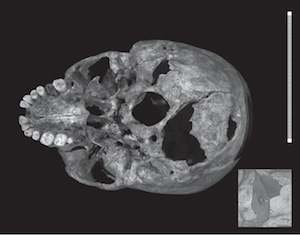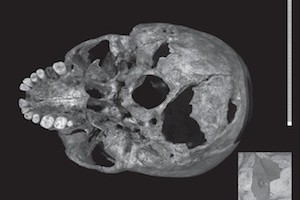
The skull of Richard III, discovered under a car park in 2012. New analysis of the monarch’s remains provide details about which of his many injuries sustained in battle were responsible for his death. (Photo credit: The Lancet)
Modern forensic techniques provide a blow-by-blow account of the injuries sustained by England’s Richard III over 500 years ago. The remains of the last English monarch to die in battle were discovered under a car park in 2012 and confirmed by DNA analysis in 2013.
The latest paper provides detailed analysis of the 11 wounds sustained by the body during the final battle, including 9 to the head which suggest that the king had removed or lost his helmet. Two of these cranial injuries were likely the fatal blows, while those sustained to the body could have happened after death.
Video originally posted by TheLancetTV on YouTube.
Original research paper published in The Lancet on September 16, 2014.
Names and affiliations of selected authors

